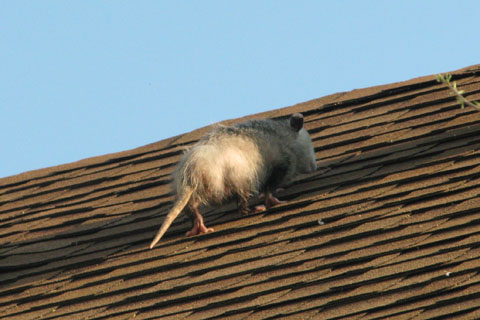| 383 | Wild Petting | 2010-04-29 |

A couple of months ago I commented on a story where a woman was injured trying to pet a moose… Okay, that did not sound like the smartest idea, because moose are really big and can be dangerous if they feel threatened.
The moose article made me start thinking of other things in the wild we should not pet. In the southeast we unfortunately do not have moose, grizzlies, mountain lions, or buffalo; but that doesn't mean we can just pet everything in the forest. So, here is a list of a few things not to try to pet in the wilds …
Raccoons - The little bandits are adept at scavenging for food. Very few trash receptacles are designed well enough to keep the raccoon from finding an entry point. The critters look cute scurrying around the campsite; but they also are one of the leading carriers of rabies. Stay away.
Mice - The trail shelters along the Appalachian Trail are filled with domesticated mice. Untidy hikers cook and eat in the shelters, leaving morsels for the mice to eat. Soon mice populations live off the hikers leftovers. The cute little mice love to run across your head at night and they can be carriers of hantavirus and have you ever heard of the Bubonic plague … reason enough to leave them alone.
Opossum - One of the ugliest creatures I have ever seen is the possum. It looks like a big rat. They have such a great immune system they really do not carry that many diseases; but still who would want to pet one?
Wild Boars/Pigs - As a kid I raised pigs for a couple of years. I actually thought it would be fun; but I had watched too many episodes of Green Acres. Even domesticated pigs have coarse hair and weird skin. Wild pigs are nothing but a problem. They root up gardens and farm crops and are ranked as an invasive species. They tip the ugly scale ranking near the possum.
Poison Ivy - Okay, who would pet a poison ivy plant? I guess no one intentionally, but still it is one of my my things not to touch! If you are not allergic to the urushiol oil you are one lucky person. The rest of us have to avoid the toxic leaves at all costs.
Hurt Animals - When you see a hurt animal, it seems that our natural instinct is to provide comfort for the injured one; but be careful. A few years back, our wonderful, loving, very gentle, dog, Jake, had been climbing all day in the mountains. His pads were sore, swollen, and even bleeding from the rough rocks and snow. My wife was tending carefully to his paws when he snapped at her. Poor Jake was hurting and so he tried to stop the hurt. (Jake now wears boots in the mountains and we also treat his pads with a toughener.) Be especially careful around a hurt animal.
Timber Rattler - Okay, don't pet a rattler, or for that matter any other snake you cannot identify. Generally, snake petting is not a problem; because most people do not like snakes. Most folks are afraid of snakes, and avoid trying to love on them like they are a puppy.
Black Bear - We do not have grizzlies in the south; but we do have black bears. Southern black bear encounters are very rarely dangerous and even less dangerous if the human allows the bear to be a wild animal. Treat the bear with respect and give them room. If you spot a bear, observe them from a distance. Never try to feed, pet, or pose for a photo with a bear. Always store food properly. Let them be wild.
Skunk - So what can be more dangerous than a bear? Well, what about a skunk? The skunk is really not that dangerous, other than rabies, but their potential odor bomb leaves most folks running away. I recently read about an Appalachian Trail hiker who claimed that on two nights a skunk slept in the foot of his sleeping bag with him. It must be pretty lonely out there on the trail!
Then for the final thing not to pet in the southeast…
Armadillo - This grub and insect eating animal is kin to the anteater. He seems to mind his own business; but we find that the dillo can give leprosy to humans due to the humans petting or eating dillo meat. I have read the Bible, and I don't want anything to do with leprosy. I'd rather takes my chances at punching a black bear in the nose than surviving the skin rotting disease! You can take your chances but I'll leave them alone.
I weeded through many candidates before choosing these ten. It is okay for your list to differ from mine. It was just a fun topic.
A short reminder, treat all creatures big and small with respect and allow them to be wild. If you need to pet something, Jake the dog is for rent. He only snaps when he is hurt!
Happy leave 'em wild trails